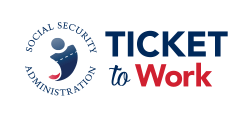Electronic Payment (E-PAY)
E-PAY Processing
To reduce Employment Networks' (EN) administrative burden of creating and submitting payment requests to the Ticket Program Manager (TPM), the Social Security Administration automated the payment process. Social Security implemented a new Electronic Payment (E-PAY) process for qualified ENs with expanded enhancements that replaced the "ePay" or automated payment processes previously in place. The intent of E-PAY is to provide ENs a means to obtain payments once Social Security eliminated the Certification Payment Process. E-PAY does not replace the process of ENs submitting payment requests via the Ticket Portal. Submitting payment requests via the Ticket Portal if ENs have primary evidence should be the first option for submitting payment requests to the TPM. Due to Social Security rules, some potential claims will not be eligible for payment under the E-PAY process.
Under the new E-PAY process, ENs do not need to take any actions to opt in (sign up) which was a requirement for prior automated payment processes. Social Security systems will perform a search of qualified ENs' active Tickets which meet Social Security rules for the E-PAY process. This process consists of an automated systems check of all current Ticket assignments against earnings records posted to Social Security databases that meet Social Security rules for E-PAY to assess if there are possible payments TPM has not paid to ENs. The process will include milestone and outcome payments, and also split payments. TPM will pay any claim month that has not been paid under a current Ticket assignment if earnings are available to meet a specific payment type criteria and all other criteria is met (e.g., beneficiary payment status). The new E-PAY process will automatically trigger Reconciliation Payments at Outcome 12 if TPM has not paid all available milestones.
TPM or Social Security Systems will make payment assessments on all situations where earnings criteria are met for current Ticket assignments. Listed below are examples where earnings criteria may be met; however, TPM is not able to process payments.
Reasons TPM/SSA is Unable to Make a Payment
If a beneficiary has earnings at or above Substantial Gainful Activity (SGA) level and TPM has not previously made a payment for the month Social Security identifies earnings at or above SGA, TPM may not make payments for the following reasons:
- TPM has paid all Phase 2 milestones which require earnings at SGA or above and the beneficiary must be in a current pay status. The next available payments are outcomes; however, beneficiaries must be in a payment status of "suspense or non-pay due to work and earnings" to be eligible for outcome payments. The beneficiary is in a current pay payment status (i.e., receiving a Federal monthly benefit payment. Outcomes are not payable.
- The beneficiary may be in a non-pay or suspended payment status not due to work and earnings. The beneficiary must be in a non-pay or suspended payment status due to work and earnings to be eligible for outcome payments.
- Ticket terminated - No Ticket payments available.
- The maximum number of outcome payments have been made.
- Beneficiary has earnings at or above Trial Work Level (TWL), but less than SGA, and TPM did not previously make a payment for the month Social Security identified.
- Due to Look Back earnings; one or more Phase 1 milestone payments may not be available for payment. If all Phase 1 milestone payments are unavailable due to LB earnings, the beneficiary is in a current pay payment status (receiving a Federal monthly benefit payment) and earnings are greater than or equal to TWL, but less than SGA, no payments are available.
- Outcome Period Entered - Beneficiary was placed in a suspense or non-pay payment status for any period (e.g., one month or multiple months) after the Ticket was assigned and then placed in a current pay payment status. For those months after a beneficiary enters an outcome period, no additional milestone payments (Phase 1 or Phase 2) can be paid. The only payments available would be outcome payments for months the beneficiary meets the requirements of earnings at or above SGA and in a suspense or non-pay payment status. After TPM pays the 12th outcome payment, the automated Ticket to Work System (iTOPSS) will identify and generate a reconciliation payment. The reconciliation payment is a total of all available milestone payments that were not paid to the EN because the beneficiary entered the outcome period. Payments denied due to Phase 1 Milestone Exclusions (i.e. Successful VR closure status or 18 MLB) will not be included in Reconciliation Payments.
- Other – Ticket Unassigned.
When to Expect Payment Deposits
ENs can expect deposits to bank accounts from E-PAY processing approximately five business days after Social Security and TPM process payments. ENs may check the status of claims processed by accessing "List Payments Already Made to Me" in the Ticket Portal.

